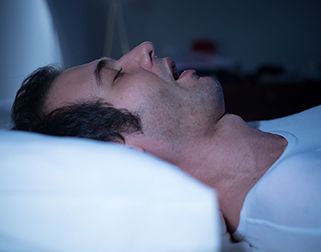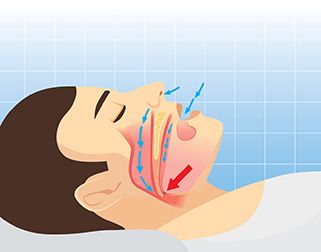Chronic Snoring
Snoring occurs in almost 20% of the adult population. The majority of snorers are men who usually began snoring in adolescence. In some cases, snoring can occur in children, especially if they have enlarged tonsils or adenoids.
There are common characteristics of people who snore, the most common being: nasal obstructions (polyps, deviated septum), thickening of the uvula (“bell”), soft palate, adenoids or amygdala, and anatomical anomalies that cause an obstruction of the upper respiratory tract and fat deposits on its walls, typical in those who are obese. The common denominator of all these situations is the existence of permanent or functional narrowing that can take place on various levels in the upper respiratory tract, producing an intense vibration on the walls of the pharynx, which transforms into the sound we perceive as snoring.

Snoring rarely bothers the snorer, but it does bother those that hear it. Sharing a room with a snorer can be a dramatic and maddening experience.
Dreaming Snores Study – Stop Snoring
Some practical suggestions to try to improve it are:
- If the snoring is worse while sleeping on one’s back, this position should be avoided. A very simple but effective solution is to put two tennis balls into a cloth bag. The upper and lower ends of this bag are attached with two safety pins to the back of the clothing in which the snorer sleeps. Sometimes elevating the head of the bed up to 45 degrees can be sufficient.
- Dry air can irritate and sometimes inflame the nasal mucous membrane so installing a humidifier can be useful.
- Some foods contain substances (allergens) that cause allergic reactions and can contribute to narrowing the respiratory tract. Although the identification of these substances can be a laborious process, it’s worth the effort. To do so, record what is eaten (breakfast, lunch, and dinner) and the severity of snoring each day for three or four weeks.
- Alcohol tends to cause the relaxation of the pharynx muscles, making them vibrate when air passes by, causing snoring. Drinking alcoholic beverages should be avoided in the evenings.
- The use of certain drugs used to sleep ( Benzodiazepines ) worsens the severity of snoring and sleep apnea.The dry snuff the airway mucosa , inflaming . You need to treat non-smoking.
- Elevating the head of the bed or using more than one pillow can be useful.
- Surgery may be an alternative, especially if there is any anatomical abnormality predisposing someone to snoring, such as a deviated septum or thickening of the uvula or soft palate. In recent years, minimally invasive surgery techniques have become available, which can be performed under local anesthesia and have a quick postoperative recovery.
- Mandibular advancement devices offer a non-invasive alternative to treat snoring. They are a type of “dental tray” that is used while sleeping to move the lower jaw forward with respect to the maxilla, thereby widening the retrolingual area. Thus, they can eliminate snoring and apnea while they are used at night. They are easy to use and it usually only takes a few days to get used to them.
